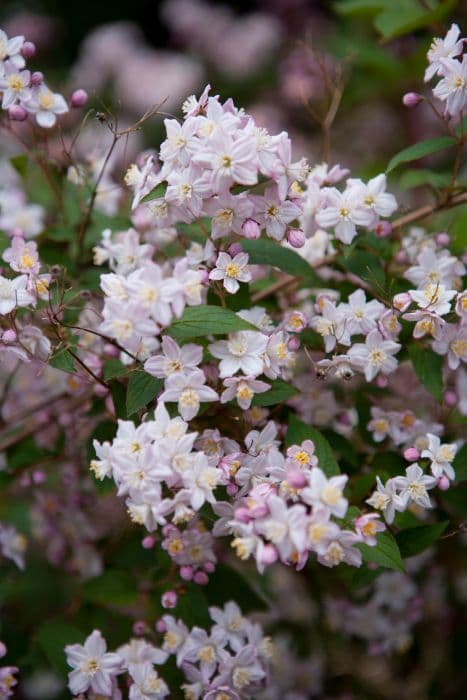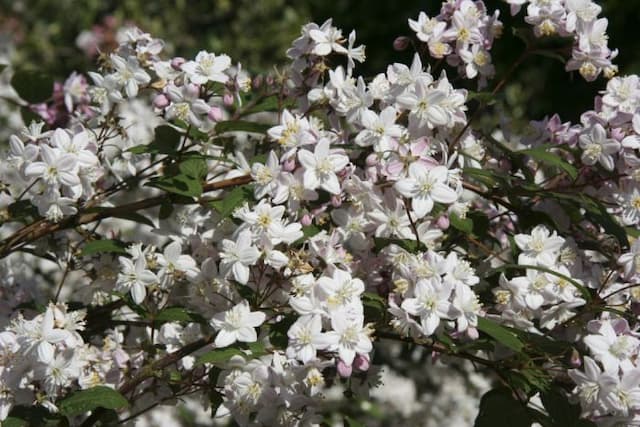Oakleaf Hydrangea Ice Crystal Hydrangea quercifolia Ice Crystal = 'Hqopr010' (PBR)
ABOUT
The Ice Crystal Oakleaf Hydrangea features a distinctive and eye-catching appearance. Its leaves are lobed similarly to those of an oak tree, lending to the common name "Oakleaf." Each leaf has deep indentations, giving a somewhat scalloped effect, with a texture that feels slightly rough. The foliage undergoes a beautiful transformation throughout the seasons. It begins as a fresh green in spring, matures into a lush, deeper green as the plant blooms through the summer, and finally turns to rich shades of red, bronze, or purple in the fall. The blooms of the Ice Crystal Oakleaf Hydrangea are no less remarkable. They consist of numerous small flowers clustered together in large, conical panicles that can create a stunning visual display. These blossoms typically start off white and may age to a delicate pink as the season progresses. The contrast between the blooms and the foliage can be quite dramatic, especially as the leaves change color in the autumn. The plant's branches and stems contribute a rugged look to the overall appearance, with a bark that can exfoliate to reveal a rich brown inner layer. This textural bark adds winter interest when the plant has shed its leaves. The Ice Crystal Oakleaf Hydrangea, with its seasonal colors, intriguing leaf shape, and striking flower panicles, creates a compelling presence in any garden setting it adorns.
About this plant
 Names
NamesFamily
Hydrangeaceae.
Synonyms
Oakleaf Hydrangea 'Ice Crystal', Ice Crystal Oakleaf Hydrangea.
Common names
Hydrangea quercifolia Ice Crystal = 'Hqopr010' (PBR)
 Toxicity
ToxicityTo humans
Oakleaf Hydrangea is generally considered to have a low level of toxicity to humans. However, if ingested, parts of the plant, particularly the leaves and buds, can cause stomach upset, nausea, vomiting, and diarrhea due to the presence of compounds such as hydrangin. Contact with the sap may also cause skin irritation in sensitive individuals. It's advisable to keep this plant out of the reach of children who might accidentally ingest parts of it.
To pets
Oakleaf Hydrangea is also toxic to pets, including dogs and cats. Consumption of any part of the plant can lead to gastrointestinal upset, such as vomiting and diarrhea. This is attributed to the hydrangin found within the plant's leaves and flower buds. Pets may also experience depression or lethargy after ingesting this plant. It's important to prevent pets from accessing and eating any part of the Oakleaf Hydrangea to avoid these symptoms.
 Characteristics
CharacteristicsLife cycle
Perennials
Foliage type
Deciduous
Color of leaves
Green
Flower color
White
Height
4-5 feet (1.2-1.5 meters)
Spread
4-6 feet (1.2-1.8 meters)
Plant type
Shrub
Hardiness zones
5
Native area
Southeastern United States
Benefits
 General Benefits
General Benefits- Easy to grow: The Oakleaf Hydrangea 'Ice Crystal' is known for being relatively easy to care for, requiring minimal maintenance once established.
- Attractive foliage: This variety boasts deeply lobed, oak-like leaves that provide textural interest in the garden throughout the growing season.
- Seasonal interest: It offers year-round interest with white, conical flower clusters in summer and foliage that turns reddish-purple in fall.
- Drought tolerance: Once established, the Oakleaf Hydrangea 'Ice Crystal' has moderate drought tolerance, making it suitable for gardens with occasional water shortages.
- Shade tolerance: It is capable of thriving in partially shaded conditions, which is ideal for gardens with limited direct sunlight.
- Wildlife attraction: The flowers can attract pollinators such as bees and butterflies, enhancing biodiversity in the garden.
- Structural plant: Its sturdy branches and overall growth habit make it an excellent choice for adding structure to garden beds and borders.
- Winter interest: The peeling bark and remaining flower heads can add visual interest to the winter garden.
 Medical Properties
Medical PropertiesThis plant is not used for medical purposes.
 Air-purifying Qualities
Air-purifying QualitiesThis plant is not specifically known for air purifying qualities.
 Other Uses
Other Uses- Pressed Flower Art: The Ice Crystal Oakleaf Hydrangea can provide beautiful flowers for pressed flower crafts, which can then be used to create unique artwork, bookmarks, or cards.
- Photography Subject: Their attractive form and stunning white blooms make Ice Crystal Oakleaf Hydrangeas excellent photography subjects for nature photographers or those looking to capture the essence of a garden.
- Educational Tool: Schools and botanical gardens might use the Ice Crystal Oakleaf Hydrangea to teach about plant identification, the lifecycle of plants, or the importance of biodiversity in ecosystems.
- Garden Design: These hydrangeas can be used to create a textured backdrop in landscape design, either by planting them as a hedge or as part of a mixed border.
- Fabric Dyeing: The various colors of the hydrangea blooms, which can shift based on soil pH, may be used for fabric dyeing, creating subtle natural hues for textiles.
- Seasonal Decor: When dried, the flowers can serve as long-lasting decorations for fall or winter, adding a natural element to indoor arrangements or wreaths.
- Theme Gardens: Due to their significant presence, Ice Crystal Oakleaf Hydrangeas can be a key plant in themed gardens, such as white gardens or woodland settings.
- Wedding Decor: Fresh or dried blooms can be incorporated into wedding decor, from table centerpieces to bridal bouquets, particularly for rustic-themed weddings.
- Floral Arrangements: The broad, conical flower head of the Ice Crystal Oakleaf Hydrangea adds a dramatic accent in both fresh and dried floral arrangements, suitable for various occasions.
- Habitat Support: Although not specifically a food plant, these hydrangeas can offer shelter to small animals and beneficial insects within a garden ecosystem.
Interesting Facts
 Feng Shui
Feng ShuiThe Oakleaf Hydrangea is not used in Feng Shui practice.
 Zodiac Sign Compitability
Zodiac Sign CompitabilityThe Oakleaf Hydrangea is not used in astrology practice.
 Plant Symbolism
Plant Symbolism- Emotional Expression: Hydrangeas, including the Ice Crystal variety, often symbolize the ability to express heartfelt emotions, including love, gratitude, and understanding.
- Apoplogy: In Japan, hydrangeas traditionally symbolize an apology or gratitude for being understood, making them a fitting gift after a misunderstanding.
- Vanity: In certain contexts, hydrangeas can symbolize vanity or boastfulness, likely due to their showy and abundant blooms.
- Beauty: The Oakleaf Hydrangea 'Ice Crystal' is prized for its distinctive leaf shape and lush flowers, making it a symbol of beauty and grace in the garden.
- Abundance: With its full clusters of long-lasting flowers, the Oakleaf Hydrangea 'Ice Crystal' can represent abundance and prosperity.
- Heartfelt and Sincere Emotions: The lavish bloom of 'Ice Crystal' may convey deep and sincere emotions when given as a gift.
 Water
WaterThe Oakleaf Hydrangea should be watered deeply and thoroughly to encourage root growth; aim to water the plant once a week, with about 1 to 1.5 gallons of water per session, but make sure to adjust based on weather conditions. During particularly hot or dry periods, you may need to water twice a week, while in cooler, rainy spells, you can reduce the frequency. Ensure the soil around the Oakleaf Hydrangea remains moist but not waterlogged, as too much water can lead to root rot. Young plants will require more consistent moisture to establish themselves, but once established, they can tolerate slightly drier soils.
 Light
LightThe Oakleaf Hydrangea thrives best in partial shade, particularly in the afternoon, to protect its leaves and blooms from intense sun. A spot that receives morning sunlight with dappled shade in the afternoon is ideal for this plant. Avoid placing it in deep shade, as this will reduce the vibrancy of its fall foliage and may impact flower production.
 Temperature
TemperatureThe Oakleaf Hydrangea can endure temperatures as low as 10 degrees Fahrenheit but prefers a range between 60 and 80 degrees for optimal growth. It is generally hardy in USDA zone 5 through 9, meaning it can withstand winter chills and summer heat within these zones. To ensure the healthiest growth, aim to provide it with conditions that avoid the extremes of its tolerance, keeping it within the ideal temperature range whenever possible.
 Pruning
PruningPrune the Oakleaf Hydrangea immediately after flowering in late summer as it blooms on old wood. Remove spent flowers and any dead or crossed branches to encourage healthy growth and improve air circulation. Periodic thinning of the plant helps maintain an attractive shape and prevents overcrowding, which can decrease bloom production. Pruning should not be too drastic, as this plant relies on last year's growth to produce its flowers.
 Cleaning
CleaningAs needed
 Soil
SoilOakleaf Hydrangea Ice Crystal prefers well-draining soil rich in organic matter with a slightly acidic to neutral pH, around 5.5 to 7. For ideal growth, a mixture of garden soil, compost, and perlite or pine bark would provide the necessary drainage and nutrient content. The soil should retain moisture without becoming waterlogged.
 Repotting
RepottingOakleaf Hydrangea Ice Crystal doesn't usually require frequent repotting as it is primarily grown outdoors. In containers, repotting every 2-3 years is sufficient to refresh the soil and accommodate root growth. It's best repotted in the spring before active growth starts.
 Humidity & Misting
Humidity & MistingOakleaf Hydrangea Ice Crystal thrives in average outdoor humidity levels. It prefers an environment that simulates its natural habitat, where humidity is moderate to high. Specific humidity levels are not critical, but avoiding excessively dry air is beneficial.
 Suitable locations
Suitable locationsIndoor
Provide bright indirect light and keep soil moist.
Outdoor
Plant in partial shade; water regularly; mulch to retain moisture.
Hardiness zone
5-9 USDA
 Life cycle
Life cycleThe Oakleaf Hydrangea 'Ice Crystal' begins its life as a seed, germinating in moist, well-drained soil with partial to full shade exposure. Upon sprouting, the seedling develops into a young plant with distinctively lobed leaves resembling oak leaves, and eventually matures into a dense, multi-stemmed shrub typically up to 6 feet tall. The mature shrub blooms in late spring to early summer, producing long conical clusters of white flowers that gradually fade to pink and then brown as the season progresses. After pollination, typically by bees, the flowers produce small dry capsules as fruits, containing the seeds for the next generation. Throughout the fall, the foliage turns to rich shades of bronze, crimson, or purple, providing seasonal interest before shedding leaves for winter dormancy. The plant can live for many years, with its woody stems becoming thicker and more extensive, forming a larger clump or thicket as it ages.
 Propogation
PropogationPropogation time
Spring-Early Summer
The most popular method of propagating the Oakleaf Hydrangea 'Ice Crystal' is through softwood or semi-hardwood cuttings. This method is typically done in late spring or early summer when the plant's new growth is still tender but beginning to mature. You'll want to take a cutting from a healthy branch that is about 4 to 6 inches long, making sure there are at least two or three pairs of leaves. Remove the lower leaves and dip the cut end into a rooting hormone. The cutting should then be placed in a well-draining potting mix, with the remaining leaves left exposed to light. Maintain consistent moisture and high humidity around the cutting by covering it with a plastic bag or placing it in a propagation chamber until roots have developed, which typically takes a few weeks. After rooting, the cutting can be gradually acclimatized to less humid conditions before being planted out.








![Hydrangea [Early Sensation]](/_next/image?url=https%3A%2F%2Fplants-admin.emdemapps.com%2Fimages%2Fplants%2F%2Fimages%2F604b6150338db.png&w=640&q=75)
